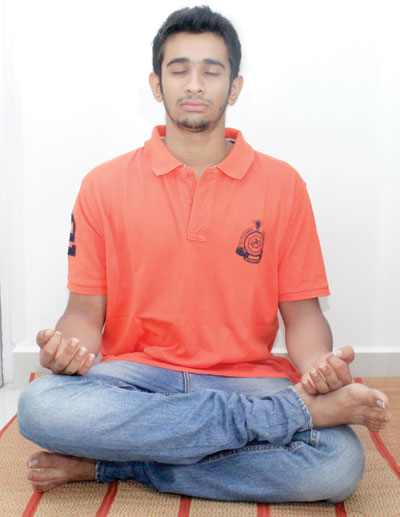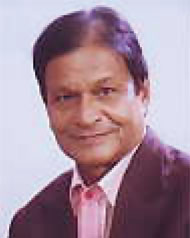- Home
- Archive -July 2012
- Minding your ow. . .

Minding your own mind
- In :
- Personal Growth
By Dr. Devender Jain
July 2012
By Dr Devendra Jain
Dr. Devendra Jain says that ‘mind management’ will lead you to life management ultimately
 |
While there are many institutes of business management, there are hardly any on mind management. Newspapers and TV news channels are full of instances of road rage, suicides, homicides, and accidents. Controlling and managing thoughts, emotions, feelings, and imagination, is what mind management is all about.
Why do we need mind management?
Your mind controls your body. When you think of any tasty dish or fruit, your mouth waters. When you are angry, or in a mood to fight, your heart beats faster, you breathe faster, and all your muscles become tense in preparation for a fight or flight. When you see a tiger ready to pounce on you from a bush, in your dreams, you wake up from the nightmare, hyperventilating to find your shirt wet with perspiration. That is how our body is affected and responds to real situations, as well as to imaginary ones. Therefore, to control your body, you must know how to control your mind. All thoughts and emotions arise in your mind. Medical science also agrees that almost 85 per cent of all diseases have their origin in the mind, which in turn affects your body. Just as anger, frustration, and fear, affect your body in a negative way, the memories of happy moments, or success, affect your body in a positive way. When you feel happy in a serene and tranquil ambience, your blood pressure comes down, and you feel calm and relaxed. It has been found that violent emotions evoke severe attacks of asthma, result in cardiac arrests, cause diabetes to flare up, and lead to hypertension, and even a stroke, causing paralysis.
To remain healthy, you must know how to manage your thoughts and emotions. Once you do that, you will learn to respond, rather than react, to any situation. There is a difference between reaction and response. Reaction is an instantaneous response. It is a conditioned reflex arising from your previous experiences. Examples of reaction are seen in cases of road rage, which have become all too common. If somebody does not give way to you on a highway, you overtake him from the wrong side, stop his car, and before he understands, shoot him dead. For this crime, you may have to cool your heels behind bars for life. Had you responded, instead of reacted, you could have waited for a few more minutes. Maybe he did not have enough space to move aside, or may not have heard your horn.
You need to be attentive and concentrate on whatever you are doing. Many accidents occur even in broad daylight, because your attention was diverted. You just could not see the speeding vehicle coming from the opposite direction. You were wide awake, your eyes fully open, yet you could not see it, because your attention was not on the road ahead. Eyes are passive organs, which perceive light and transmit the information to the appropriate portion of the brain. Interpreting and understanding them is the job of your mind. Consciousness, attention, awareness, and concentration, are the functions of our mind. Similarly, there is a difference between hearing and listening. Sound waves impinging on your ear drums, and conveyed to the inner ear and appropriate portion of your brain, is hearing. When you pay attention to what is said, it becomes listening. It needs your full attention. You remember something only when you listen. If what you see has your undivided attention, it becomes an observation. Normally, you do not forget what you observe. Once you know the art of observing your thoughts and emotions, you will not react but respond. You can even decide whether responding is worthwhile. Mostly we think negatively. We imagine and visualise the worst case scenarios, because of our actions, and magnify our suffering.
Mind control techniques guide us to reprogramme our subconscious mind, so that only positive and constructive thoughts and emotions enter our consciousness.
Effective techniques of mind management
• Passive meditation is the most effective tool for mind control. There are various techniques of meditation, but the underlying principle is the same, which is to fix the mind on some item such as your breath, body sensations, or your thoughts, which invade your consciousness in an unending stream. The secret of meditation is to observe your thoughts and emotions, without involving yourself in any way. Do not react, just be an observer, an uninterested spectator. Keep your full attention on your breathing process, the air striking your nostrils, being warmed, and going down your air passages and lungs. It will anchor you to the present, keeping the mind away from its favourite game of dwelling either in the past, or in the future. It is in the nature of thoughts that if you do not pay any attention to them, and do not react emotionally to them, they will just disappear, without lingering. Thoughts appear from deep recesses of your mind. They come in quick succession, without giving you a respite even for a few seconds. They will not harass you, if you just watch them, and are a neutral observer.
• Active meditation can be done anywhere, anytime. You do not have to sit in a particular pose. Pay full attention to whatever you are doing, and be fully absorbed in it. While walking pay full attention to the activity, feel the soft and wet grass, drenched from the morning dew under your feet. Listen to the whisper of air rustling through the trees.
| When you feel happy in a serene and tranquil ambience, your blood pressure comes down, and you feel calm and relaxed. | ||
Listen attentively to the chirping of birds, and inhale the pleasant whiffs of fragrance wafting through the air from myriad varieties of flowers. See, and wonder at the riot of colours in flowers. Similarly, while eating an orange, pay full attention to its tangy aroma, taste, and look at the bright orange colour. It anchors you in the present, which you can enjoy, without being bothered by past memories, whether sweet or sour, and without being anxious about the unpredictability and uncertainty about future.
• Thought stopping: Whenever unwelcome negative thoughts intrude into your consciousness, if you are alone shout loudly, “Stop!” If somebody else is present, repeat it silently. You will find that the incessant flow of thoughts stops at once.
• Thought switching: Replace negative thoughts with positive ones. It is a feature of the mind that only one thought can be entertained at a time. If you are depressed, think and visualise past successes and happy times. If anger strikes you, think of love, kindness, and forgiveness.
• Tratak is one of the tantrik sadhanas. Tratak is looking at a point constantly, without blinking the eyes, as much as possible. You can look at anything. It may be a candle light or a black circle pasted on the wall in the line of your sight, or it may even be a photograph. It is really a wonderful and simple technique, but it should be learnt under the guidance of a qualified guru, as the technique puts you in direct contact of your subconscious mind. It should not be trifled with, as it could cause problems, including mental problems.
• Pranayama is intimately connected with our thoughts and emotions. When you are angry, you breathe faster. At happy moments, your breathing is deep and slow. When sexually excited, you breathe faster. When you want to listen to a distant faint sound, you hold your breath to listen to it intently. As our thoughts and emotions affect our breathing pattern, we can change it to reverse engineer our mind, and control our thought processes and emotions. While you are ill, depressing thoughts will come to you. Pranayama is a wonderful technique to manage our mind. Our rishis, sages, and wise men delved deep into the consciousness. and found that our breathing was intimately related with our emotions, thoughts, memories, and feelings. They discovered that our left nostril breathing is connected with the right brain, and our right nostril breathing is connected with our left brain. Our left brain is the thinking brain, while our right brain is the feeling brain.
 Dr Devendra Jain is an allopathic Dr Devendra Jain is an allopathicdoctor who has written several article on alternative medicine and life sciences in leading newspapers and magazines. He is also a fellow of the American Association of Professional Hypnotherapists, USA |
If you remove the cap of a man’s skull, you will clearly see two hemispheres of the brain like kernels of a walnut. The left brain thinks, applies logic, and analyses the available data, to reach a decision. whereas the right brain feels, visualises, and intuits. Our mind is filled with immense possibilities, which border gifts like precognition, psychokinesis (moving objects simply by the power of mind), psychometry (telling everything about an object and its possesso
r), and other psychic powers.
All our conflicts arise due to conflict between our thinking and feeling brain hemispheres. We want to do something and behave in a particular way, but our common sense and rational sense (left brain) say otherwise. By balancing both the hemispheres with anulom vilom pranayama, we can achieve harmony of thoughts and emotions. Alternate breathing pranayam, i.e. anulom vilom pranayam, achieves this objective of balancing feeling and thinking brain.
• Self-hypnosis is the technique of relaxing the mind to the alpha state. In this condition, you are fully aware of whatever is happening around you, but it does not bother you. You are in a blissful state. You are in direct contact with your subconscious mind without the interference of your conscious mind. You can reprogramme your mind, get rid of the negative and limiting thoughts and emotions, such as depression, anxiety, various phobias, and drug addiction. You can have full control over your sensation of pain, heal your body miraculously, get rid of your inferiority complex, and stuttering. Good luck. Do not stop till your mind is as obedient as a puppy dog.
To read more such articles on personal growth, inspirations and positivity, subscribe to our digital magazine at subscribe here
Life Positive follows a stringent review publishing mechanism. Every review received undergoes -
- 1. A mobile number and email ID verification check
- 2. Analysis by our seeker happiness team to double check for authenticity
- 3. Cross-checking, if required, by speaking to the seeker posting the review
Only after we're satisfied about the authenticity of a review is it allowed to go live on our website
Our award winning customer care team is available from 9 a.m to 9 p.m everyday
The Life Positive seal of trust implies:-
-
Standards guarantee:
All our healers and therapists undergo training and/or certification from authorized bodies before becoming professionals. They have a minimum professional experience of one year
-
Genuineness guarantee:
All our healers and therapists are genuinely passionate about doing service. They do their very best to help seekers (patients) live better lives.
-
Payment security:
All payments made to our healers are secure up to the point wherein if any session is paid for, it will be honoured dutifully and delivered promptly
-
Anonymity guarantee:
Every seekers (patients) details will always remain 100% confidential and will never be disclosed
